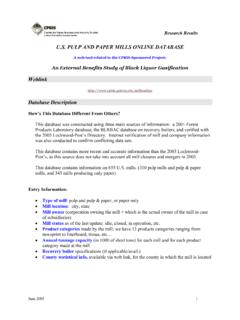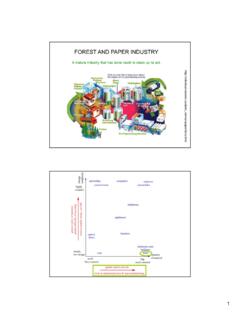Transcription of Report-China Pulp and Paper Industry - Front Page
1 China s pulp and Paper Industry : A Review* Zhong Zhuang Lan Ding Haizheng Li School of Economics Georgia Institute of Technology _____ We would like to thank Xian Fu, Renyu Li, Li Liang, Zhiyong Liu, Yang Peng, Valentin Todorov, Zhimin Xin, Luping Yang for assistance on data and company visit. China s pulp and Paper Industry : A Review Abstract In this report , we provide an overview of the pulp and Paper Industry in China, based on both Industry level data and firm level data. We discussed the Industry on its current stand, pattern and trends, relative importance in the world, and its transformation.
2 More specifically, in addition to the general discussion of the pulp , Paper , and paperboard sector, we also analyzed structural change on the demand during the course of economic transition, capacity expansion and foreign direct investment, company performance, and discrepancy of data from different sources. Finally, we introduced two representative companies visited in China for this study. Key Words: Chinese pulp Industry , Chinese Paper Industry 1. Introduction The development of the China s pulp and Paper Industry is drawing increasing interest among scholars, policy makers, and international producers.
3 Chinese Paper and paperboard production ranked in the world, and reached million metric tons in 2004 and increased to 56 million in 2005. In 2005, Chinese consumption of Paper and paperboard reached million metric tons. Chinese pulp production, which attained million metric tons (Mts) in 2004, was also one of the top 3 producers in the world since 1995. However, as to the per capita consumption of Paper and paperboard, China has been ranked very low in the world, ranging from 57 to 68 in the world. In 2005, Chinese consumption was only 45 kg per capita, which was very low compared 300 kg per capita in countries such as the United States and Therefore, The Chinese market has a great potential for Paper and paperboard products.
4 The pulp and Paper Industry is one of the very few industries in China that has been experiencing shortages in supply. The domestic production cannot satisfy the domestic consumption, especially for high quality Paper and paperboard products, due to old production technique and lack of high-quality raw Therefore, unlike other Chinese products, China has been importing more pulp and Paper product than exporting. Other distinguishing characteristics of the Chinese pulp and Paper Industry include limited wood resources, rapid expansion of capacity, direct investment from foreign producers, co-existence of large modern mills vs.
5 A large number of out-of-dated small mills, and a large portion of state-ownership. Moreover, the advantage of low cost of labor for this Industry in China is not significant. Those features raise many interesting questions for researchers and policy makers. In this report , we review the pulp and Paper Industry in China. The goal is to provide a picture of this Industry about its current stands, relative importance in the world, and its transformation and trends, using both Industry level data and firm level data. In 1 Data is available at China s Foreign Investment Web: 2 Although recently the Chinese domestic production overran the demand on some grades of Paper and paperboard, generally the situation went the other way round on most of grades of Paper and paperboard in the Chinese market.
6 2 Section 2, we discuss the pulp sector, and then the Paper and paperboard sector in Section 3. Section 4 analyzes the structural change on demand during the course of economic transition. We discuss capacity expansion and foreign direct investment in Section 5. Using company level data, we will study company performance in Section 6. Given the existence of discrepancy of data from different sources, we briefly discuss this issue in Section 7. In Section 8, we introduce two representative companies visited in China for this study. Section 9 concludes. 2. Chinese pulp Industry The pulp Industry is one of the very few industries in China that has been experiencing shortages.
7 Domestic pulp production increased at an average annual rate of during However, in the same period, pulp consumption grew at a much faster pace, an average yearly rate of The domestic pulp production cannot meet the demand and the gap has widened, as shown in Graph 1. In 2005, the domestic pulp production was million Mts, while the consumption was million Mts, a much bigger gap than that of million Mts in 1991. The gap for some pulp grades is even larger. For example, for chemical wood pulp , which has become increasingly popular in China, the gap has soared since 1995 (Graph 2).
8 The lack of forest resources is the main reason for the shortage of high quality pulp . Although the total stock volume of forest increased from billion cubic meters in 1994 to billion cubic meters in 2003 in China, and in the same period, the forest coverage rate grew from to , the forest coverage is still very low, about 61% of the world average and ranked 130th in the world. Per capita forest stock volume is cubic meters, only one sixth of the world average and ranked the 122nd in the Despite the efforts of expanding fast-growing plantations, the shortage of supply of wood for pulp production has shaped the pulp / Paper Industry in China.
9 In particular, 3 For the pulp categories, the following common divisions are used: mechanical pulp (produced by a mechanical process), chemical pulp (produced by a chemical process), semi-chemical pulp (made by a chemical process followed by a mechanical process), and other pulp (for example, recycled pulp ). 4 The growth rates are calculated from the raw data provided by Chinese Statistical Book 2003. 5 Data is available at XINHUANET: 3wood pulp is only a small portion of the total pulp used in Paper making, less than one fourth.
10 Recycled pulp and other fiber pulp accounted for more than three fourths of the total pulp . The extensive use of non-wood pulp indicates that a large portion of domestically made Paper and paperboard is in low quality. Traditionally, China used a large proportion of non-wood pulp made from reed, grass and straw. The ratio of domestic wood pulp usage was only , while non-wood pulp accounted for about one third of the pulp used in 2001 (Table 1). Grass and straw pulp accounted for of all pulp used, about four times the amount of domestic wood pulp . However, the usage of non-wood pulp has been declining.









